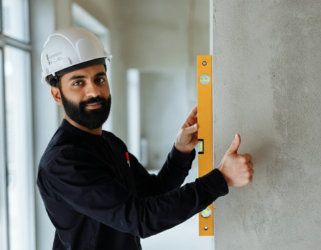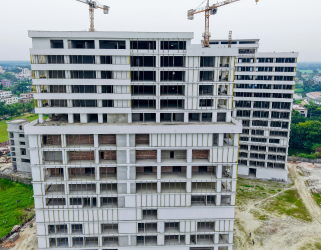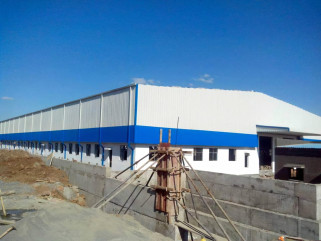Hybrid Construction: Blending Steel and Concrete for Maximum Strength

When it comes to modern construction, the ability to deliver structures that are not only durable but also sustainable, cost-effective, and adaptable is more critical than ever. Hybrid construction offers an innovative approach by combining steel and concrete, capitalizing on the strengths of both materials to achieve high-performance building solutions.
This method integrates steel frames with concrete cores or slabs, bridging the gap between speed, strength, and design flexibility. Whether you're working on skyscrapers, industrial facilities, or mixed-use developments, hybrid steel concrete structures are transforming how we think about construction. Let's explore how this composite construction method works and why it’s gaining traction in the industry.
The Foundation of Hybrid Construction
At its core, hybrid construction fuses two powerful materials. Steel, known for its high tensile strength and adaptability, forms the skeleton of the building. Concrete, celebrated for its compressive strength and durability, adds solidity and resilience. By combining these materials, builders can create steel concrete hybrid buildings that offer unparalleled advantages.
Imagine a commercial high-rise needing both a lightweight steel framework for floors and a robust concrete core for elevators and stairs. Hybrid construction delivers both, resulting in faster assembly, higher structural integrity, and greater design possibilities.
Why Hybrid Construction? The Advantages Explained
Hybrid construction is not just a passing trend. It exists because it addresses longstanding issues in both traditional steel and concrete construction methods. Here's why it’s making waves in the industry:
1. Enhanced Structural Integrity
Steel brings flexibility and strength to a structure, while concrete provides stability and resistance to pressure. Together, they result in a balance that neither material can achieve alone.
Take the example of earthquake-resistant construction. Steel frames can absorb shock and movement, while concrete cores provide the mass and stability needed to keep the structure grounded. This synergy makes hybrid steel concrete structures particularly suitable for areas prone to seismic activity.
2. Faster Construction Timelines
Efficiency is a major advantage of hybrid construction. Steel components, often prefabricated off-site, can be quickly assembled on location. Concrete slabs, especially when precast, complement the speed of steel assembly.
Consider an industrial project Metrosh worked on recently, where steel frames were installed within weeks, followed closely by precast concrete floor slabs. The entire building was operational months ahead of schedule, saving both time and cost for the client.
3. Cost-Effectiveness
Hybrid construction optimizes the use of materials. Steel frames require less material overall due to their strength-to-weight ratio, and by integrating them with concrete, the need for additional reinforcements can be minimized.
For projects with tight budgets, composite construction methods allow precise material allocation, ensuring no excess resources are wasted. By combining steel and concrete in thoughtful ways, Metrosh has proven that even ambitious projects can stay well within financial parameters.
4. Design Flexibility
One of the standout features of steel concrete hybrid buildings is their versatility. Steel frames are ideal for large spans and open layouts, with minimal columns interrupting the space. At the same time, concrete’s plasticity allows for intricate designs, curves, and unique architectural features.
Picture a sprawling sports complex, where hybrid construction provides steel-structured wide arenas and concrete for seating and support systems. This combination ensures functionality without compromising on aesthetics.
5. Sustainability
Hybrid construction aligns with green building goals by reducing waste and leveraging sustainable materials. Steel is highly recyclable, while concrete can incorporate eco-friendly additives like fly ash or slag, further lowering its environmental footprint.
Metrosh integrates composite construction methods that prioritize sustainability, ensuring every hybrid project contributes to a greener planet.
How Hybrid Construction Works
Hybrid construction methods are more than just mixing materials; they require careful planning and integration to maximize the strengths of steel and concrete. Here’s a step-by-step breakdown of how this process comes together:
- Design Phase: Engineers and architects collaborate to determine where steel frames and concrete cores best serve the structure’s needs. For instance, steel frames might be ideal for upper floors, while concrete bases anchor the building.
- Prefabrication: Steel components are fabricated off-site for precision and efficiency. Similarly, concrete slabs or panels can be precast, ensuring uniformity and reducing on-site work.
- On-Site Assembly: Steel frames are erected first, followed by the integration of precast concrete elements. This sequence allows overlapping work phases, significantly accelerating timelines.
- Finishing Touches: Hybrid construction ensures seamless integration, with concrete and steel connections stabilized using advanced composite construction techniques. The result is a unified structure that leverages the advantages of both materials.
Case Studies of Hybrid Construction in Action
To see hybrid construction’s potential, we don’t have to look far. Major projects worldwide are using this approach to deliver groundbreaking results:
- Industrial Plants: Hybrid steel concrete structures provide open spans for machinery while concrete elements handle vibrations and load-bearing needs.
- Urban High-Rises: Combining steel frames with reinforced concrete floors allows faster assembly while meeting rigorous safety standards.
- Mixed-Use Buildings: Hybrid construction enables the combination of residential, commercial, and recreational spaces in a single project without compromising on utility or design.
Metrosh has successfully implemented hybrid construction for clients needing both speed and durability. A recent manufacturing facility utilized steel frames for its warehouse wings and concrete for office blocks, resulting in a multi-functional space delivered on time and on budget.
Is Hybrid Construction Right for Your Project?
If you're considering hybrid construction for your next venture, take a moment to weigh your priorities. This method is particularly effective if your project demands:
- Large spans with minimum columns.
- Tight construction timelines.
- A balance of durability and flexibility.
- Sustainability with efficient material use.
From warehouses to skyscrapers, hybrid construction offers a wide range of applications, making it a favorite for modern, high-performance buildings.
Closing Thoughts
Hybrid construction is shaping the future of the industry, merging the strength of steel and the dependability of concrete to create buildings that are both practical and innovative. Whether for industrial hubs, urban towers, or mixed-use developments, this composite method delivers remarkable results.
At Metrosh, we specialize in designing and delivering steel concrete hybrid buildings that excel in structural integrity, sustainability, and cost-efficiency. By integrating customizable steel frames with durable concrete cores, we ensure every project meets the highest standards of performance and safety.
If you’re seeking a construction solution that combines speed, strength, and sustainability, hybrid construction with Metrosh is the clear choice. Together, we’re building not just structures, but a stronger future for the industry.
More Services:
Pre Engineered Buildings | Civil Construction | Hybrid Constructions
FAQs
1. Why combine steel and concrete in hybrid construction?
Combining steel and concrete enhances strength, flexibility, and durability, creating more efficient and robust structures.
2. What are the key benefits of hybrid construction systems?
It offers faster construction, cost efficiency, greater design flexibility, improved sustainability, and superior structural integrity.
3. Which types of buildings are best suited for hybrid construction?
Ideal for high-rises, industrial facilities, mixed-use projects, and large-span structures.
4. Is hybrid construction more expensive than PEB or traditional methods?
Hybrid construction can be costlier than PEB but more affordable than traditional RCC in many cases.
5. What are the common challenges in hybrid construction projects?
Challenges include material coordination, skilled labor management, seamless integration, and cost control.
Related Articles

Why Pre-Engineered Buildings Are the Ultimate Cost-Saving Solution?
24 Sep 2025
Strong, Durable, and Long-Lasting: The Structural Superiority of PEBs
23 Sep 2025
Quality Control in Civil Construction: Metrosh Infra’s Standards and Practices
22 Sep 2025
Cost-Efficiency in Hybrid Construction: Balancing Budget and Quality
22 Sep 2025
Building the Future: Metrosh Infra’s Approach to Turnkey Civil Construction
20 Sep 2025


